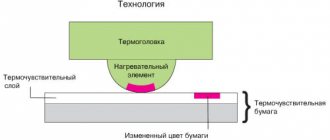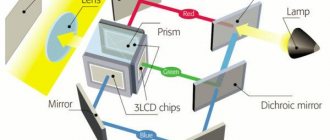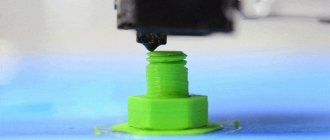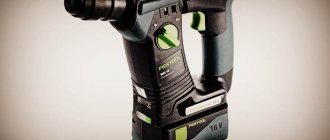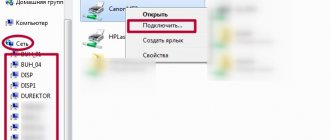The operating principle of a laser printer is not as complicated as it may seem to an ordinary user who has not previously delved into how office equipment works. In this article we will look in detail at what the device consists of and how it works. A detailed diagram of the laser action will help with this. Let us separately consider what a cartridge is and why it prints, which actually does 80% of the work of the entire mechanism.
How often do you use your printer?
- A couple of times a month. 33%, 53 votes
53 votes 33%53 votes - 33% of all votes
- Few times a week. 25%, 40 votes
40 votes 25%
40 votes - 25% of all votes
- Never yet*15%, 24 votes
24 votes 15%
24 votes - 15% of all votes
- Every day. 11%, 17 votes
17 votes 11%
17 votes - 11% of all votes
- Once every 25 minutes*8%, 12 votes
12 votes 8%
12 votes - 8% of all votes
- Once every 10 years*6%, 10 votes
10 votes 6%
10 votes - 6% of all votes
- every day*3%, 4 votes
4 votes 3%
4 votes - 3% of all votes
Total votes: 160
04.12.2019
* - added by visitor
×
You or from your IP have already voted.
Where did laser printing come from?
In the middle of the last century, or to be precise, in 1938, an American physicist and inventor was the first to patent a method for transferring dry paints to sheets of paper. All this was possible by using static energy in the form of electricity. Just 10 years later, Xeror took the electrographic transfer method as a basis in its first printing devices. It took another decade to “bring it to fruition” and release the technology that automatically performed printing. Only then did printers appear that could be called that.
The first model was called the Xerox 9700 and went on sale in 1977. The users of such technology were large offices and enterprises. Some characteristics of that device even meet modern requirements. For example: speed of 120 sheets per minute, duplex two-sided printing. Five years later, in 1982, the first model for home use was released. It is produced by Canon. Afterwards, the rapid development of the market begins, in which different brands with their own models appear one after another.
History of creation
The method of transferring dry dye to paper was patented in 1938 by US inventor and physicist Chester Carlson. The method was based on the use of static electrical energy. The technology was adopted by Xerox 10 years later. It took another 10 years to refine the electrographic transfer method and to invent a device that could automatically display information on paper. At first the machine was cumbersome and some operations had to be done manually. Only in the 50s. A fully automated mechanism was created, which is the prototype of modern laser printing technology.
The laser beam was added to the printer design by Xerox in 1969, and the first printer went on sale in 1977. It was the Xerox 9700 model. Only large companies and offices could buy the innovative device, since the price exceeded 300 thousand. The speed of the first printing technology was 120 pages per minute, it could do double-sided printing. Printers became available to ordinary private users after 5 years. They were started to be produced by Canon. Then the number of manufacturers and new models of printing equipment increased rapidly every year.
What does the equipment consist of?
In stores you can buy a model for any need with a minimal or a very large set of different functions. But every laser printer is based on the same technology and operating principle. The basis is photoelectric xerography, and inside the device can be divided into several large parts.
- Laser scanning mechanism. The block consists of a large number of lenses and mirrors. All of them are capable of rotating in order to ultimately apply the desired image to the surface of the photodrum. The application itself occurs with a special laser only in the right places. The result is an invisible picture, because the surface charge simply changes, and it is impossible to see it with the naked eye. The operation of the scanning mechanism is controlled by a controller with a raster processor.
- Block for transferring images to paper. The second block consists of a cartridge and a charge transfer roller. The cartridge itself is a rather complex mechanism, which includes a photodrum, a charge shaft and a magnetic one. It is the photoshaft that can change its charge under the influence of the laser.
- The node where the final fastening to the paper occurs. When the toner from the photo cylinder hits the paper, it is immediately placed in the printer oven, where it melts under high temperature and is fixed on the surface of the sheets.
Data exchange and “communication” between different printer components occurs using an interface unit.
- In most cases, laser devices use powder dyes, which are initially positively charged. Therefore, the laser will “draw” the image negative, due to which the toner will be attracted to the surface of the photo roll. This option is used in equipment from Xerox, HP, and Canon. This allows you to maximize the detail of the drawing on paper.
- Brother, Epson and Kyocera brands use a different technique. The toner has a negative charge, and the laser changes the charge not of the areas where the dye will fall in the future, but, on the contrary, of the places where it will not be located. This option allows you to achieve greater uniformity of distribution of the dye on the surface of the paper.
- Some “processing” also occurs with the paper after it gets inside the printer. Its properties are changed using a transfer roller. To be precise, the static charge is simply removed after using the neutralizer. This prevents it from being attracted to the photo shaft in the future.
- Toner powder contains substances that easily melt at high temperatures and are securely attached to paper. Laser printer printouts are not erased and are well preserved for a long time.
How a laser printer works and works
Laser printers have become indispensable attributes of office equipment. This popularity is explained by the high speed and low cost of printing. To understand how this technique works, you should know the structure and operating principle of a laser printer. In fact, all the magic of the device is explained by simple design solutions.
The history of laser printing technology
Back in 1938, Chester Carlson patented a technology that transferred images to paper using dry ink. The main engine of work was static electricity. The electrographic method (and this was exactly what it was) became widespread in 1949, when the Xerox Corporation took it as a basis in the operation of its very first device. However, it took another decade of work to achieve logical perfection and complete automation of the process - only after that the first Xerox appeared, which became the prototype of modern laser printing devices.
The first Xerox 9700 laser printer
The first laser printer itself appeared only in 1977 (it was the Xerox 9700 model). Back then printing was done at a speed of 120 pages per minute. This device was used exclusively in institutions and enterprises. But already in 1982, the Canon desktop unit was the first to come out. Since that time, numerous brands have been involved in the development, which to this day offer new versions of desktop laser printing assistants. Every person who decides to use such equipment will be interested in learning more about the internal structure and operating principle of such a unit.
What's inside
Despite the large assortment, the design of the laser printer of all models is similar. The work is based on the photoelectric part of xerography, and the device itself is divided into the following blocks and units:
- laser scanning unit;
- node that transfers the image;
- knot for fixing the image.
The first block is represented by a system of lenses and mirrors. This is where a semiconductor type of laser with a lens capable of focusing is located. Next are mirrors and groups that can rotate, thereby forming an image. Let's move on to the unit responsible for image transfer: it contains the toner cartridge itself and the roller that transfers the charge. The cartridge alone contains three main image-forming elements: a photocylinder, a pre-charged roller, and a magnetic roller (working in conjunction with the device’s drum). And here the ability of a photocylinder to change its conductivity under the influence of light falling on it becomes of great relevance. When a photocylinder is given charge, it retains it for a long time, but when exposed to light, its resistance decreases, which leads to the fact that the charge begins to drain from its surface. This is how the impression we need appears.
In general, there are two ways to create a picture.
- Almost all laser printers use toners that have a positive charge - here the laser will highlight areas with potential image locations. This is the operating principle of laser printers from HP, Canon, and Xerox brands. This provides fine detail in the image.
HP-2500 color theory
The principle of printing toner with a negative charge
Getting into the unit, immediately before future contact with the photocylinder, the paper itself receives a corresponding charge. The image transfer roller helps her with this. After transfer, the static charge disappears with the help of a special neutralizer - this is how the paper stops being attracted to the photo cylinder.
How is the image captured? This happens due to the additives that are in the toner. They have a certain melting point. This “oven” presses molten toner powder into the paper, after which it quickly hardens and becomes durable.
Images printed on paper with a laser printer have excellent resistance to numerous external influences.
How the cartridge works
The determining element in the operation of a laser printer is the cartridge. It is a small bin with two compartments - for working toner and for already used material. There is also a photosensitive drum (photocylinder) and mechanical gears for turning it.
The toner itself is a finely dispersed powder, which consists of polymer balls - they are coated with a special layer of magnetic material. If we are talking about a color toner, then it also contains coloring agents.
It is important to know that each manufacturer produces its own original toners - they all have their own magnetism, dispersion and other properties.
That is why you should never refill cartridges with random toners - this may negatively affect its performance.
The process of creating an impression
The appearance of an image or text on paper will consist of the following successive stages:
- drum charge;
- exposure;
- development;
- transfer;
- consolidation
Drum charge
How does photo charging work? It is formed on the photodrum (where, as is already clear, the future image itself is born). To begin with, a charge is supplied, which can be either negative or positive. This happens in one of the following ways.
- A corona wire is used, that is, a tungsten filament coated with carbon, gold and platinum inclusions. When high voltage comes into play, a discharge is carried between this thread and the frame, which, accordingly, creates an electric field that transfers charge to the photodrum.
- However, the use of filament led to problems with contamination and deterioration of the printed material over time. A charge roller with similar functions works much better. It itself looks like a metal shaft, which is covered with conductive rubber or foam rubber. There is contact with the photocylinder - at this moment the roller transfers the charge. The voltage here is much lower, but the parts wear out much faster.
Exhibition
This is the work of illumination, as a result of which part of the photocylinder becomes conductive and passes a charge through the metal base in the drum. And the exposed area becomes uncharged (or acquires a weak charge). At this stage, a still invisible image is formed.
Technically it works like this.
- The laser beam falls on the surface of the mirror and is reflected onto the lens, which distributes it to the desired location on the drum.
- This is how a system of lenses and mirrors forms a line along the photo cylinder - the laser is turned on and off, the charge either remains intact or is removed.
- Has the line ended? The image drum will rotate and exposure will continue again.
Development
In this process, the magnetic shaft from the cartridge is of great importance, similar to a metal tube, inside of which there is a magnetic core. Part of the roller surface is placed in the refill toner hopper. The magnet attracts the powder to the shaft and it is carried out.
It is important to regulate the uniform distribution of the powder layer - for this there is a special dosing blade . It allows only a thin layer of toner to pass through, throwing the rest back. If the blade is not installed correctly, black streaks may appear on the paper.
After this, the toner moves to the area between the magnetic roller and the photo cylinder - here it will be attracted to the exposed areas and repelled from the charged ones. This way the image becomes more visible.
Transfer
In order for the image to appear on paper, a transfer roller comes into play, the metal core of which attracts a positive charge - it is transferred to the paper thanks to a special rubberized coating.
So, the particles come off the drum and begin to move onto the page. But they are held here so far only due to static tension. Figuratively speaking, the toner is simply poured where needed.
Dust and paper lint may get in with the toner, but they are removed by a wiper (special plate) and sent straight to the waste compartment on the hopper. After a full circle of the drum, the process is repeated.
Pin an image
To do this, the property of toner to melt at high temperatures is used. Structurally, the following two shafts help with this:
- there is a heating element in the top;
- at the bottom, melted toner is pressed into the paper.
Sometimes such a “stove” is a thermal film - a special flexible and heat-resistant material with a heating component and a pressure roller. Its heating is controlled by a sensor. Just at the moment of passage between the film and the pressing part, the paper heats up to 200 degrees, which allows it to easily absorb the toner that has become liquid.
Further cooling occurs naturally - laser printers usually do not require the installation of an additional cooling system. However, here a special cleaner passes through again - usually a felt roll plays its role.
Felt is usually impregnated with a special compound, which helps lubricate the coating. Therefore, another name for such a shaft is oil.
How is color laser printing done?
How does color printing happen? A laser device uses four such primary colors - black, magenta, yellow and cyan. The printing principle is the same as in black and white, but the printer will first split the image into monochrome for each color. Each cartridge begins sequentially transferring its own color, and as a result of the overlay, the desired result is obtained.
The following color laser printing technologies are distinguished:
With the multi-pass option, an intermediate carrier comes into play - this is a roller or tape that carries the toner. It works like this: in 1 revolution, 1 color is applied, then another cartridge is fed to the right place, and the second one is placed on top of the first picture. Four passes are enough to form a full-fledged picture - it will be transferred to paper. But the device itself will work 4 times slower than its black and white counterpart.
HP 4-Pass Laser Technology
How does a single pass printer work? In this case, all four separate printing mechanisms have a common control - they are lined up in one line, each with its own laser unit with a portable roller. So the paper goes along the drum, sequentially collecting all four images of the cartridges. Only after this pass does the sheet go into the oven, where the picture is fixed.
The advantages of laser printers have made them favorites for working with documentation, both in the office and at home. And information about the internal components of their work will help any user to notice shortcomings in time and contact the service department for technical support for the operation of the device.
Cartridge device
The main element of any printing device is the cartridge. It can be a regular one, which consists of two bins, for toner and waste, and a photo cylinder. There are also drum cartridges. Their design allows it to be divided into toner and photocell.
What is the difference between drum and toner cartridges? Details about drum unit, toner and print devices.
Inside one of the compartments is toner. This is a special fine-grained powder that is black or purple, yellow and blue in the case of a color printer. The substance has certain physical properties, and from different manufacturers they differ in grain size, magnetization and dispersity. Therefore, there is no universal dye that is suitable for all printer models.
The cartridge looks approximately as shown in the figure below. Appearance may vary depending on the model. But the printing principle of a laser printer remains the same regardless of the design. Consists of the following parts:
- A toner hopper in which powder is stored waiting to be used for printing.
- A magnetic shaft through which the toner passes from its storage location to the photocell.
- The metering blade controls the thickness of the powder layer that is applied to the surface of the drum.
- The squeegee cleans the image drum after it comes into contact with a sheet of paper after transferring dye onto the paper from its residues.
- The charge roller produces a charge on the surface of the photoroll.
- Compartment for waste powder.
- Some models are equipped with chips. These are small microboards for collecting information about the number of printed sheets. The chip can be replaced if necessary.
Almost all the main elements become unusable over time, but can be replaced since they are consumables. The cartridge itself can be refilled a large number of times until the gears and housing elements are completely worn out.
Structural elements of a laser printer
Regardless of the model, any laser printing machine has a modular design consisting of the following parts:
- laser scanning module (printed circuit board);
- image forming unit (cartridge);
- paper feed unit;
- thermal unit.
The printed circuit board is a module protected by a cover, consisting of the following elements: a semiconductor laser with a lens that focuses the beam, a mirror rotating using a motor, a group of lenses guiding the laser beam, and a mirror.
Important! The laser beam generated by the printed circuit board is directed into the image-forming module - the cartridge.
Cartridge design feature
The design of a cartridge for a laser printer is a separate, replaceable housing with elements inside, the purpose of which “for dummies” is not very clear. Among them:
- photosensitive drum;
- charging roller;
- squeegee for cleaning the photo layer from residual ink particles;
- toner reservoir;
- magnetic shaft with core;
- coloring powder dispenser, the so-called “Doctor”;
- seal (removed when installed in the printer).
Unlike matrix and inkjet printer models, in which characters transmitted by the processor to the print head are reproduced on paper using an ink ribbon or drops of ink, the printing process in a laser machine is multi-step. So, first the photodrum is pre-charged, then the latent image is exposed with a laser, then the print is transferred to paper, followed by heat treatment .
Basic Consumables
The main consumable material for laser printing equipment is the cartridge. After an important node has exhausted its resource, the user has three maintenance options.
- Buy a new original replacement copy, which is quite expensive.
- Purchase a compatible printed circuit assembly from a third-party manufacturer. This is an acceptable economy option.
- Use the services of a service company specializing in the repair and maintenance of office equipment, whose list of services includes restoration/refilling of cartridges. This is a super economical option. But after 3-4 refills, the photodrum wears out, and you will have to use option 1 or 2.
Scheme and principle of operation
Drum charge
The photocylinder of the laser cartridge is coated with a special sensitive layer of green or blue color. Less common, but there are other shades. Depending on the manufacturer of the laser printer, the charge transferred to the shaft can be a positive or negative charge. The process itself can be carried out in two ways.
- A special tungsten filament (corotron) coated with carbon, gold or platinum particles is used. To charge the photodrum, a magnetic field is created due to the high voltage applied to the filament. The main disadvantage of this element is constant contamination, which leads to deterioration in the display of a picture or text already on paper.
- The charge roller does the job better (does not leave dirt on the paper over time) than the corotron. It performs the same function. Visually it looks like a metal shaft coated with a conductive substance. Basically it is special rubber or foam rubber. Charge transfer occurs during contact with the photo shaft. The resource of the roller is much less than that of the corotron.
What is an image drum in a printer? Detailed information about this cartridge part.
Creating an Image
At this stage, an invisible image is formed on the surface of the photo roll, which corresponds to what you see on the monitor screen of your computer or laptop. This process is called exposure. The pattern occupies a surface with a negative or positive charge. The work of changing the charge is carried out by a laser beam, which first hits the mirror and then the lens.
One line of the design is formed by turning the laser on or off. Then the drum is rotated and a new part of the picture is applied. Everything happens in a matter of seconds. Excess toner is collected with a squeegee and goes into the waste bin.
Development
The main part of this process is a magnetic shaft in the form of a metal tube with a magnetic core inside. The part fits tightly to the photo cylinder and toner hopper. During operation, it rotates, and due to the presence of a magnet inside, it attracts dye to its surface. At the same time, it applies toner to the surface of the photocell. In places where the toner charge differs from the same characteristic of the roller, the ink “sticks”.
Transfer to paper
This part of the process uses a transfer roller. The metal base allows you to change its charge, and thereby transfer it to sheets of paper. In the same way as with a magnetic roller, the powder is “transferred” from the photoroller to the paper. Static tension allows you to keep the powder on the surface, but outside the printer it will simply scatter across the sheet.
Consolidation
To ensure that the toner is securely attached to the surface, it is literally baked into paper. This is facilitated by the property of the toner to melt under the influence of high temperature, which is created by the stove inside the laser printer. And also two shafts are involved in the process. There is a heating element on the top one, and the bottom one presses the paper for secure fixation. The thermal film that is involved in the process is heated to a temperature of about 200 degrees. Schematically, everything looks like this.
The film is used in budget series models. More expensive ones use Teflon and lamps. This increases the service life of the fastening mechanism.
Video
The process of creating an impression
The process of how the printer works is as follows:
- Having received a print command from the computer, the drum begins to rotate. A rubber roller rotates with it, which charges the photodrum with negative particles.
- The laser zeroes the charge in those places where text or design is to be applied.
- Negatively charged toner particles fall on neutral areas - this is how an image is formed.
- With the help of special rollers, a sheet of paper is charged with positive particles that arise during friction.
- A drawing or text is transferred to the paper due to the difference in charge.
- The image is fixed by the fact that a special oven, which is located in the printing block, “bakes” it into the paper under the influence of high temperature (about 200 degrees Celsius).
- The remaining waste ink is cleaned off with a rubber roller, and the drum is charged again with the same roller.
Important! Some printers use an image transfer ribbon. If it is available, then the image is first formed on it and then transferred to the photodrum.
Features of color printing
Often, a color laser printer uses four cartridges: black, cyan, magenta, and yellow. More expensive and modern models may have more of them. The principle of operation is similar to the monochrome version, but differs slightly due to the need to apply not one, but several different shades at once. In the process, each cartridge applies its own color separately from the others. Depending on the number of passes, this type of equipment is divided into single and multi-pass.
- In the multi-pass version, a “middleman” is used. This can be a separate shaft or tape. First, one color is applied on the first revolution of the photo roll. Then the second and everyone else in turn. The operating time is increased by four times for a complete color image application. After this, the finished picture goes directly onto the paper.
- With the single-pass option, all four cartridges apply their pattern simultaneously during the first pass of the shafts. They are each equipped with their own laser system and portable roller. This method of application is faster in speed. And also, in terms of purchase price, such printers are more expensive than conventional ones.
Important features of color laser printers:
- Laser color printing of photographs and drawings on such a printer is not as high quality when compared with the work of inkjet devices. The whole problem is the difficulty of conveying tones with dry dyes. But laser printers are more suitable for printing graphs and diagrams, and therefore are more popular in offices.
- A color device is significantly more expensive than a monochrome device, and therefore such equipment is in less demand among home users. Maintenance and consumables are also not from the budget segment. It’s worth taking this into account and finding out the details for each individual brand before purchasing.
How does a color printer work?
Color machines contain 4 cartridges with black, blue, violet and yellow toner. In expensive devices, the number of capacities may be greater.
The printing principle of a color printer does not differ significantly from the operation of a monochrome printer. The only difference is that the application of dye to obtain a color image is done separately by each cartridge. Depending on the number of passes, there are single-pass and multi-pass devices.
The multi-pass type has a special shaft or belt. One color is applied per revolution of the drum. The number of revolutions is equal to the number of colors used, due to this the total time of applying the image to the paper increases. In a single-pass device, the image is drawn with all colors at once. To achieve this, each cartridge is equipped with its own laser system and portable roller. This type of printer prints faster than a multi-pass printer, but is more expensive.
A color laser printer has its advantages and disadvantages. Compared to an inkjet, it prints faster, but the quality of the resulting image will be slightly lower due to the fact that dry ink conveys tones worse. This color rendering is sufficient for printing graphs and diagrams, which is why color printers are bought mainly for offices. It is purchased less often for the home due to the high cost of both the device itself and maintenance.
How a laser printer works and works
You can see printers from different brands on the shelves in stores, but they can all be divided into two types: inkjet and laser. If with inkjet everything is more or less clear, liquid ink is applied in a drop-drop manner, then how a laser printer works is not clear to everyone.
The history of laser printing technology
The first prototype of a laser printer was invented in 1938 by Chester Carlson, who at the time of its invention was a law student and working as a lawyer in the US Patent Office. The first sheets printed using static electricity were obtained in his home laboratory. At first he tried to sell his development to IBM. But they refused to buy the invention. Only in 1946 did the private company Xerox become interested in its scientific development. And in 1949, printers that used dry ink for printing first appeared on the market.
The first models were very bulky and required a certain level of training from operators. Ten years after the first release of the industrial model, more compact and convenient devices appeared. The model was called Xerox 914. It printed at a speed of 7 sheets per minute, which at that time was considered a very high figure. At the same time, the image quality was significantly higher than that of the then popular matrix printers.
The first laser printer appeared in 1969, all from the same Xerox. In 1978, one of the company's employees, Gary Starkweather, managed to invent a laser and install it in the device. This was the first laser printer device. However, the first model turned out to be too expensive. The price of the device was about $350,000.
Important! Some printer models use toner with positively charged particles, and the drum is charged not with negative, but with positive charges.
This difference arose because different companies used their own developments, which were considered a company secret. At that time, little was known about what a laser printer was or how it worked, but the principles by which it should work were known. When choosing toner to fill a cartridge, this must be taken into account!
As the demand for laser printers increased in the early 80s, other companies appeared that wanted to capitalize on this market. The first available model of the device was released by Cannon. Xerox eventually lost its position and left the market. Today in office equipment stores you can see laser printers of various brands. Various models have appeared, but the structure and operating principle of the laser printer remain the same.
What's inside
A laser printer consists of a board, a laser head, a printing unit - it has a built-in oven and an electric motor for rotating the drum, as well as the cartridge. The laser printer cartridge is a removable, replaceable part.
The board is the brain of the printer. Through the board, commands are transmitted from the computer to the printer, all elements that are inside the printer are controlled, including the direction of the laser beam.
Printing block. The printing block has a complex structure. It combines mechanical elements - gears and levers, with the help of which the interconnected movement of the drum, paper feed rollers, toner supply and output of the printed sheet occurs; thermal - an electric heating strip (stove), for which such a printing machine is sometimes called a thermal printer.
Cartridge. This is the main printing element of a laser printer. The laser printer cartridge device includes several interconnected components.
How the cartridge works
A laser printer cartridge consists of a drum, a rubber roller, a magnetic roller, a toner dispensing blade and a box into which the toner is poured. Gears are installed on the sides of the cartridge, with the help of which the rollers and drum are driven. The magnetic roller consists of an outer body and a magnetic core. The magnet attracts the toner particles, and the blade aligns them over the entire surface of the roller.
Interesting fact! A cartridge is a purely mechanical device that is driven by a drive. There is a small chip installed on the cartridge, but it is only needed for the computer to collect information about the number of printed pages during the entire operation of the printer. The chip can be removed - the cartridge will work the same as before.
Almost all cartridge models support toner refilling. A cartridge is a replaceable printer element. After some time, the photodrum and magnetic roller become unusable. This is accompanied by deterioration in print quality and the appearance of white and black stripes.
The process of creating an impression
The process of how the printer works is as follows:
- Having received a print command from the computer, the drum begins to rotate. A rubber roller rotates with it, which charges the photodrum with negative particles.
- The laser zeroes the charge in those places where text or design is to be applied.
- Negatively charged toner particles fall on neutral areas - this is how an image is formed.
- With the help of special rollers, a sheet of paper is charged with positive particles that arise during friction.
- A drawing or text is transferred to the paper due to the difference in charge.
- The image is fixed by the fact that a special oven, which is located in the printing block, “bakes” it into the paper under the influence of high temperature (about 200 degrees Celsius).
- The remaining waste ink is cleaned off with a rubber roller, and the drum is charged again with the same roller.
Important! Some printers use an image transfer ribbon. If it is available, then the image is first formed on it and then transferred to the photodrum.
Drum charge
Initially its charge is neutral. However, in order for the printing process to begin, its surface is charged with negative charges. This is done using a special rubber roller. Charges arise from the friction of surfaces against each other. The surface of the drum is covered with a special photosensitive coating. Therefore, under the influence of a laser, the charge on its surface can change.
Exhibition
The laser is located at the front of the laser printer body or on the side. The laser beam hits the photoshaft and changes the charge on its surface from negative to neutral (not to be confused with positive!). Exposure (illumination) of a laser linear scan with high frequency. In older models, complex focusing was done using mirrors and lenses. The printer circuit was very complex, and the device itself occupied a large area. Modern printer models are simpler, but their print quality is higher. They take up little space and can print at high speeds – up to 27 pages per minute.
Important! The drum is very sensitive to scratches. In places where the photosensitive coating is peeled off, the charge is always neutral. This affects the print quality. Black or white stripes appear in these places.
Development
A mirror image is formed on the surface of the drum. Toner particles are transferred from the magnetic roller to the surface of the drum and stick to it due to the charge difference. The development of a monochrome and color printer is different, since the structure of a color printer is more complex. In color printing, the image is first formed on an image transfer belt, and then only transferred to the drum and paper.
Interesting! If you interrupt printing and remove the cartridge from the printer, you can see the image on the drum, but only if you have not touched its surface with your fingers.
Transfer
Transfer to paper is carried out under the influence of the same static electricity. In this case, the paper does not even touch the surface of the photodrum! The paper, before being passed under the photo roller, is electrified using rubber rollers. When it passes by the drum, negative particles from it fly to the surface of the paper, which has a positive charge. An image is formed on the paper, and its surface becomes neutrally charged.
Pin an image
After the drawing or text is transferred to paper, it must be secured, otherwise the image will crumble as soon as the sheet of paper falls into your hands. The toner is fixed to the paper using a stove. The stove heats the ink particles, they melt, become liquid, penetrate deep into the paper and instantly harden. An indelible and fade-resistant high-definition image is formed.
IMPORTANT! Particles of ink (toner) begin to melt at a temperature of 180-200 degrees, regardless of whether they melted before or not. Therefore, a laser printer does not have duplex printing (software), since printing on the back side leads to deterioration in quality on the front side. In addition, caustic toxic substances that are part of toner and paper are released into the air.
How is color laser printing done?
A color laser printer has a more complex structure, but the principle of operation of the printer is the same as for monochrome. This concerns not so much the printing unit as the device of the cartridge, laser and board.
Below is a description of how the color printing process works:
- First, the digital image is processed using algorithms specially developed for this purpose and transferred to the printer control board.
- The laser forms an image on the surface of the drum.
- Toner of a certain color is supplied from different toner boxes, in a certain order, from separate nozzles.
- Small multi-colored particles of dry ink are applied to the image transfer tape. Under the ribbon there is a photo roller that attracts toner particles.
- The image is transferred to paper, and the toner particles are baked in the oven.
The result should be a high definition image. The printing process on a color printer will take longer, as the ink boxes are moved so that one or another area on the paper eventually acquires the desired color and shade. The boxes contain blue, yellow, purple and black ink. Important! Color photos on a color laser printer turn out worse than on an inkjet printer. This is due to the fact that such an image has a lot of halftones, which are more difficult for the machine to print. But the image of graphs and diagrams is better with a laser, and the colors last longer.
Although there are color laser printers on the market, they are in less demand than color inkjet printers. Buyers are put off by the price and complexity of service. However, with monochrome models the opposite is true. High printing speed, image clarity and low maintenance costs (the toner is cheap and lasts a long time) have made it an indispensable assistant in the office and at home.


